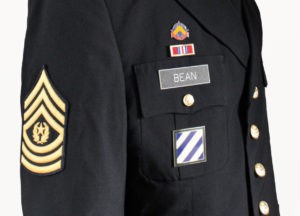Wearing your medals and ribbons on your Army dress blues is a distinguished way to represent your honorable service in the United States Army. These emblems symbolize dedication, achievements, and sacrifices made during your military career. However, proper placement isn’t just about aesthetics; it’s about upholding the high standards and regulations of military dress.
This guide serves as your essential resource for understanding the intricacies of Army dress blues, specifically focusing on the precise placement of medals and ribbons. Whether you are preparing for a formal military event, a wedding, or a funeral, ensuring your uniform is correctly adorned is a mark of respect and attention to detail. Let’s delve into the regulations, ensuring you wear your decorations with the pride and precision they deserve.
Understanding the Army Dress Blues Uniform
The Army dress blues uniform is the formal attire for U.S. Army personnel, reserved for occasions demanding a high degree of formality. This distinguished uniform comprises several key components:
- White Long-Sleeved Shirt: A crisp white shirt forms the base layer of the dress blues.
- Black Tie (or Bowtie): Typically a black four-in-hand tie is worn, though a black bowtie is appropriate for specific evening social events.
- Army Blue Coat: The iconic blue coat is the centerpiece of the uniform, serving as the canvas for medals, ribbons, and insignia.
- Army Blue Trousers: Matching blue trousers complete the formal look.
- Beret (Optional): While a beret is often worn with dress blues, headgear may be optional during evening social functions.
Beyond these core elements, the Army blue coat itself has specific requirements for adornment. It’s mandatory to display identification badges, regimental and branch insignia, as well as hash marks and overseas service bars if applicable. Furthermore, the dress blues provide the opportunity to showcase unit awards, combat and skill badges, and the full spectrum of earned medals and ribbons. Mastering the placement of these components is crucial for a sharp and regulation-compliant appearance.
Occasions for Wearing Army Dress Blues
The formality of Army dress blues dictates specific events where they are appropriate. The guidelines differ slightly between active duty personnel and veterans.
Formal Events for Active Duty Personnel
For those currently serving, the scope of events warranting dress blues is broader, encompassing occasions that emphasize national pride, respect, and military tradition. Active duty soldiers should wear dress blues for:
- National Holidays: Observances such as Memorial Day, Independence Day, and Veterans Day.
- Funerals and Weddings: Military funerals and weddings often call for the formality of dress blues.
- Parades: Participating in parades as a representative of the U.S. Army.
- Military Ceremonial Events: Formal military functions, ceremonies, and official gatherings.
It’s important to note subtle variations based on event timing. For instance, the black bowtie is typically reserved for wear after retreat, while the four-in-hand tie is standard for all other formal occasions.
Formal Events for Veterans
Veterans, while no longer on active duty, retain the privilege of wearing their Army dress blues in specific, meaningful contexts. The occasions for veterans to wear dress blues are generally centered around military connections or significant life events:
- Military-Centric Formal Events: Special ceremonies, reunions, or gatherings specifically honoring military service.
- Military Funerals and Weddings: Family events with a military connection where honoring service is appropriate.
- Burial: Veterans may choose to be buried in their Army dress blues, a final tribute to their service.
Precise Medal Placement on Army Dress Blues
Wearing medals correctly on your Army dress blues is paramount to honoring your achievements and maintaining uniform standards. Specific measurements dictate the precise placement of each type of medal and badge. Accuracy is key, and attention to these details demonstrates professionalism and respect for military protocol.
Combat and Skill Badges
Combat and skill badges are positioned to denote specialized skills and combat experience. Regulations allow for flexibility in their placement:
- Placement Above Ribbons: Badges can be worn 1/4 inch above any ribbons you are wearing.
- Placement Below Pocket Top: Alternatively, they can be positioned below the top edge of the pocket.
- Spacing: When wearing multiple badges, ensure a 1/2 inch space between each for clarity and neatness.
Marksmanship Badges
Marksmanship badges recognize proficiency in weaponry and are placed in a specific area of the uniform:
- Placement Below Ribbons: These badges are worn 1/4 inch below the bottom row of your ribbons.
- Spacing: If you have earned multiple marksmanship badges, space them 1 inch apart.
- Special Skills Badges: Any special skills badges you’ve earned should be placed to the right of your marksmanship badges, creating a distinct grouping.
Unit Awards
Awards earned collectively by your unit are displayed to recognize collective achievement and unit cohesion:
- Placement: Unit awards are centered 1/8 inch above the right breast pocket of the Army dress blues jacket. This positioning ensures they are prominently displayed yet balanced within the uniform’s design.
Hash Marks (Service Stripes)
Hash marks, also known as service stripes, indicate the length of honorable service in the Army:
- Placement Location: Hash marks are worn on the outside of the left sleeve of the dress blues jacket.
- Angle and Position: Each hash mark is placed at a 45-degree angle, with the lower end pointing towards the inside seam of the sleeve.
- Height: The stripes are centered and positioned 4 inches above the bottom edge of the sleeve.
Overseas Service Bars
Overseas Service Bars denote tours of duty served overseas, each bar representing a specific period of service:
- Placement Location: These bars are worn on the right sleeve of the Army dress blues jacket.
- Position and Spacing: They are placed on the outside of the sleeve, 4 inches above and parallel to the bottom edge. Multiple bars are worn parallel to each other, spaced 1/16 inch apart, creating a stacked and orderly appearance.
Ribbon Placement on Army Dress Blues: Achieving Uniform Excellence
Just like medals, the placement of ribbons on Army dress blues adheres to strict guidelines, ensuring uniformity and respect for the awards themselves. While the general principles are the same, there are slight variations in ribbon placement between male and female uniforms to accommodate differences in uniform design and fit.
Ribbon Placement for Male Uniforms
For male Army dress blues, ribbon placement is straightforward and standardized:
- Location: All ribbons are worn on the left side of the Army dress blues jacket.
- Positioning: Ribbons should be centered and placed 1/8 inch above the top of the left jacket pocket. This ensures they are visible and properly aligned with other uniform elements.
Ribbon Placement for Female Uniforms
For female Army dress blues, ribbon placement takes into account variations in uniform design and body shape to ensure a flattering and regulation-compliant display:
- Location: Similar to male uniforms, ribbons are worn on the left side of the jacket.
- Positioning: Ribbons are centered on the left side, with the bottom row of ribbons positioned parallel to the bottom of the nameplate.
- Adjustment for Fit: Recognizing variations in body shape, female personnel have the flexibility to adjust ribbon placement to ensure the ribbons are appropriately positioned and do not detract from the overall appearance of the uniform. The goal is a neat, centered, and professional display.
Additional Essential Details for Army Dress Blues Adornment
Beyond medals and ribbons, several other badges and insignia contribute to the complete and correct presentation of Army dress blues. Accurate placement of these items is equally important for a sharp and regulation-compliant uniform.
Identification Badges
Identification badges signify specific qualifications or duties and are placed on the right side of the uniform:
- Placement: Identification badges are positioned on the right side of the Army dress blues jacket, centered vertically between the bottom of the right pocket and the bottom of the pocket flap. This placement ensures they are balanced visually with elements on the left side of the uniform.
Distinctive Unit Insignia (DUI) Crest
The DUI crest represents the soldier’s unit affiliation and is worn on the shoulder:
- Placement: The DUI crest is placed on the left shoulder of the dress blue coat, centered between the button and the rank insignia. This location distinguishes it from other badges worn on the chest area.
Regimental Insignia
Regimental insignia signifies the soldier’s regimental affiliation and is displayed on the right side of the jacket:
- Placement: Regimental insignia is worn on the right side of the Army dress blues jacket.
- Vertical Positioning Options: It can be placed either 1/8 inch above the top of the right pocket or, if unit awards are worn, 1/4 inch above the unit awards. This provides flexibility depending on other decorations being displayed.
Stay Informed: Further Resources
Ensuring your Army dress blues are correctly assembled is a continuous aspect of military professionalism. For the most up-to-date and comprehensive information, always refer to official Army regulations and resources. Websites like Medals of America and other reputable military uniform suppliers often provide detailed guides and visual aids to assist with proper uniform assembly.
By mastering these guidelines for medal and ribbon placement, you ensure your Army dress blues reflect your service with honor, precision, and respect for military tradition. Wear your decorations with pride, knowing you are upholding the high standards of the U.S. Army.

